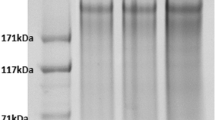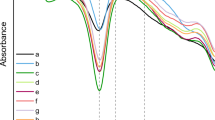Abstract
Eri silkworm (Samia cynthia ricini) is the multivoltine non-mulberry silkworm that could be cultured indoors for silk production. It has been reported that the quality of silk varies with species of silkworms and the host plants. However, the cause of quality variance in silk protein is yet to be unfolded. On this background, the present work has been designed to study the histological structure and protein profile of the silk gland and cocoon of S. c. ricini. The cellular structure of the silk gland has been studied histologically using the routine eosin-haematoxylin staining method. Silk gland and cocoon protein profile has been studied by discontinuous SDS-PAGE followed by Liquid chromatography-tandem mass spectrometry (LC-MS/MS) analysis. The results showed that the silk gland is formed by monolayer epithelial cells. The protein globules secreted from the posterior part of the gland coalesce in the lumen. The nuclei are highly convoluted in the middle and posterior silk glands in the day 01 wandering larvae for pupation. Study of protein profile by SDS-PAGE showed 36 protein bands in the whole silk gland and cocoon. LC-MS/MS analysis showed the presence of 109 protein molecules in the silk gland. These include Fibroin heavy chain, Fibrohexamerin (P25), Sericin 1 and Sericin 2. Sericin 3 was not identified in the whole silk gland and cocoon. This study will contribute data for the evolutionary study, biomaterial applications, and genetic engineering, to study the impacts of food plants, environmental parameters, and toxicity of pesticide residues on the silk gland in further studies.





Similar content being viewed by others
References
Akai H (1984) The ultrastructure and functions of the silk gland cells of Bombyx mori. Akai H, King RC (ed) Insect Ultrastructure, Plenum Press, New York, pp 323-364. https://doi.org/10.1007/978-1-4613-2715-8
Akai H, Imai T, Tsobouchi K (1987) Fine – structural changes of liquid silk in the silk gland during the spinning stage of Bombyx larvae. J Sericult Sci Japan 56(2):131–137. https://doi.org/10.11416/kontyushigen1930.56.131
Akai H, Nagashima T, Aoyagi S (1993) Ultrastructure of posterior silk gland cells and liquid silk in Indian Tasar silkworm, Antheraea mylitta Drury (Lepidoptera: Saturniidae). Int J Insect Morphol Embryol 22(5):497–506. https://doi.org/10.1016/0020-7322(93)90036-Z
Aksakal B, Tsobkallo E, Darvish D (2009) Mechanical properties of Bombyx mori silk yarns studied with tensile testing method. J Appl Polym Sci 113(4):2514–2523. https://doi.org/10.1002/app.30167
Ausubel FM, Brent R, Kingston RE, Moore DD, Seidmen JG, Smith JA, Struhl K (2002) Short protocol in molecular biology: A compendium of methods from current protocols in molecular biology. John Wiley & Sons, Inc., Canada
Barbosa P, Berry DL, Kary CS (2014) Insect histology: Practical laboratory techniques, Vol 1: 21-117. Willy Blackwell. https://doi.org/10.1002/9781118876114
Blossman-Myer B, Burggen WW (2010) The silk cocoon of the silkworm, Bombyx mori: Macro structure and its influence on transmural diffusion of oxygen and water vapor. Comp Biochem Physiol A Mol Integr Physiol 155:259–263. https://doi.org/10.1016/j.cbpa.2009.11.007
Bovilla VR, Padwal MK, Siripurapu P, Basu B, Mamillapalli A (2016) Developmental proteome dynamics of silk glands in the 5th instar larval stage of Bombyx mori L. (CSR2 × CSR4). Biochem Biophys Acta Proteins and Proteom 1864(7):860–868. https://doi.org/10.1016/j.bbapap.2016.03.013
Culling CFA (1974) Handbook of histopathological and histochemical techniques. 3rd Edn Butterworth-Heinemann, London. https://doi.org/10.1016/C2013-0-04011-X
Dash R, Soumen M, Kundu SC (2006) Isolation, purification and characterization of silk protein sericin from cocoon peduncles of tropical Tasar silkworm, Antheraea mylitta. Int J Biol Macromol 38:255-258. https://doi.org/10.1016/j.ijbiomac.2006.03.001
Dong Z, Zhao P, Zhang Y, Song Q, Zhang X, Guo P, Wang D, Xia Q (2016) Analysis of proteome dynamics inside the silk lumen of Bombyx mori. Sci Rep 6:21158–21168. https://doi.org/10.1038/srep21158
Gheysens T, Collins A, Raina S, Vollrath F, Knight DP (2011) Demineralization enables reeling of wild silkmoth cocoons. Biomacromolecules 12(6):2257–2266. https://doi.org/10.1021/bm2003362
Hardy JG, Romer LM, Scheibel TR (2008) Polymer material based on silk proteins. Polymer 49(20):4309–4327. https://doi.org/10.1016/j.polymer.2008.08.006
Ichimura S, Mita K, Zama M, Numata M (1985) Isolation of the giant ramified nuclei of the posterior silk glands. Bombyx mori Insect Biochem 15(2):277–283. https://doi.org/10.1016/0020-1790(85)90015-0
Jin H, Kaplan DL (2003) Mechanism of silk processing in insects and spiders. Nature 424(6952):1057–1061. https://doi.org/10.1038/nature01809
Koh L, Cheng Y, Teng C, Khin Y, Loh X, Tee S, Low M, Ye E, Yu H, Zhang Y, Han M (2015) Structures, mechanical properties and applications of silk fibroin materials. Prog Polym Sci 46:86–110. https://doi.org/10.1016/j.progpolymsci.2015.02.001
Kunz RI, Brancalhao RMC, Ribeiro LFC, Natali MRM (2016) Silkworm sericin: Properties and biomedical applications. BioMed Res Int 2016:1–19. https://doi.org/10.1155/2016/8175701
Lee J, Nishiyama T, Shigenobu S, Yamaguchi K, Suzuki Y, Shimada T, Katsuma S, Kiuchi T (2021) The genome sequence of Samia ricini, a new model species of lepidopteran insect. Mol Ecol Resour 21(1):327–339. https://doi.org/10.1111/1755-0998.13259
Li J, Ye L, Che J, Song J, You Z, Yun K, Wang S, Zhong B (2015) Comparative proteomic analysis of the silkworm middle silk gland reveals the importance of ribosome biogenesis in silk protein production. J Proteom 126:109–120. https://doi.org/10.1016/j.jprot.2015.06.001
Nandi A, Yan L-J, Jana CK, Das N (2019) Role of catalase in oxidative stress- and age-associated degenerative diseases. Oxid Med Cell Longev 2019:1–19. https://doi.org/10.1155/2019/9613090
Nirmala X, Mita K, Vanisree V, Zurovec M, Sehnal M (2001) Identification of four small molecular mass proteins. Insect Mol Biol 10(5):437–445. https://doi.org/10.1046/j.0962-1075.2001.00282.x
Pal S, Kundu J, Talukdar S, Thomas T, Kundu SC (2013) An emerging functional natural silk biomaterial from the only domesticated non-mulberry silkworm Samia ricini. Macromol Biosci 13(8):1020–1035. https://doi.org/10.1002/mabi.201300013
Qi Y, Wang H, Wei K, Yang Y, Zheng R, Kim IS, Zhang K (2017) A review of structure construction of silk fibroin biomaterials from single structures to multi-level structures. Int J Mol Sci 18(3):237–298. https://doi.org/10.3390/ijms18030237
Rivera-Vega LJ, Acevedo FE, Felton GW (2017) Genomics of Lepidoptera saliva reveals function in herbivory. Curr Opin Insect Sci 19:61–69. https://doi.org/10.1016/j.cois.2017.01.002
Rockwood DN, Preda RC, Yücel T, Wand X, Lovett ML, Kaplan DL (2011) Materials fabrication from Bombyx mori silk fibroin. Nat Protoc 6(10):1612–1631. https://doi.org/10.1038/nprot.2011.379
Sasaki S, Nakajima E, Fujii-Kuriyama Y, Tashiro Y (1981) Intercellular transport and secretion of fibroin in the posterior silk gland of the silkworm Bombyx mori. J Cell Sci 50(1):19–44. https://doi.org/10.1242/jcs.50.1.19
Sezutsu H, Tamura T, Yukuhiro K (2008) Leucine-rich fibroin gene of the Japanese wild silkmoth, Rhodinia fugax Lepidoptera (Saturniidae). Eur J Entomol 105(4):561–566. https://doi.org/10.14411/eje.2008.075
Sezutsu H, Yukuhiro K (2000) Dynamic rearrangement within the Antheraea pernyi silk fibroin gene is associated with four types of repetitive units. J Mol Evol 51(4):329–338. https://doi.org/10.1007/s002390010095
Sezutsu H, Yukuhiro K (2014) The complete nucleotide sequence of the Eri-silkworm (Samia cynthia ricini) fibroin gene. J Insect Biotechnol Sericol 83(3):59–70. https://doi.org/10.11416/jibs.83.3_059
Shi R, Ma S, He T, Peng J, Zhang T, Chen X, Wang X, Chang J, Xia Q, Zhao P (2019) Deep insight into the transcriptome of the single silk gland of Bombyx mori. Int J Mol Sci 20(10):2491–2507. https://doi.org/10.3390/ijms20102491
Shishodia SK, Shankar J (2020) Proteomic analysis revealed ROS-mediated growth inhibition of Aspergillus terreus by shikonin. J Proteom 224:103849. https://doi.org/10.1016/j.jprot.2020.103849
Taba M, Gogoi H (2019) Report on wild Eri silkworm Samia canningii Hutton (Lepidoptera: Saturniidae) from Arunachal Pradesh, India. Natl Acad Sci Lett 42(2):147–150. https://doi.org/10.1007/s40009-018-0678-2
Tabb DL, Eng JK, Yates JR (2001) ) Protein identification by SEQUEST. In: Peter J (ed) Proteome Research: Mass Spectrometry. Principles and Practice. Springer, Berlin, pp 125–142. https://doi.org/10.1007/978-3-642-56895-4_7
Takasu Y, Hata T, Uchino K, Zhang Q (2010) ) Identification of Ser2 proteins as major sericin components in the non-cocoon silk of Bombyx mori. Insect Biochem Mol Biol 40(4):339–344. https://doi.org/10.1016/j.ibmb.2010.02.010
Takasu Y, Yamada H, Tamura T, Sezutsu H, Mita K, Tsubouchi K (2007) Identification and characterization of a novel sericin gene expressed in the anterior middle silk gland of the silkworm Bombyx mori. Insect Biochem Mol Biol 37:1234-1240. https://doi.org/10.1016/j.ibmb.2007.07.009
Takasu Y, Yamada H, Tsubouchi K (2002) Isolation of three main sericin components from the cocoon of the silkworm, Bombyx mori. Biosci Biotechnol Biochem 66(12):2715–2718. https://doi.org/10.1271/bbb.66.2715
Tanaka K, Mizuno S (2001) Homologues of fibroin L-chain and P25 of Bombyx mori are present in Dendrolimus spectabilis and Papilio xuthus but not detectable in Antheraea yamamai. Insect Biochem Mol Biol 31(6–7):665–677. https://doi.org/10.1016/S0965-1748(00)00173-9
Tashiro Y, Morimoto T, Matsuura S, Nagata S (1968) Studies on the posterior silk gland of the silkworm, Bombyx mori I. Growth of posterior silk gland cells and biosynthesis of fibroin during the fifth larval instar. J Cell Biol 38(3):574-588. https://doi.org/10.1083/jcb.38.3.574
Tsubota T, Yamamoto K, Mita K, Sezutsu H (2016) Gene expression analysis in the larval silk gland of the Eri silkworm Samia ricini. Insect Sci 23(6):791–804. https://doi.org/10.1111/1744-7917.12251
Waku Y, Sumimoto K (1974) Ultrastructure of Lyonet’s gland in the silkworm (Bombyx mori L.). J Morphol 142(2):165–185. https://doi.org/10.1002/jmor.1051420205
Willcox PJ, Gido SP, Muller W, Kaplan DL (1996) ) Evidence of a cholesteric liquid crystalline phase in natural silk spinning processes. Macromolecules 29(15):5106–5110. https://doi.org/10.1021/ma960588n
Xia Q, Li S, Feng Q (2014) Advances in silkworm studies accelerated by the genome sequencing of Bombyx mori. Annu Rev Entomol 59:513–536. https://doi.org/10.1146/annurev-ento-011613-161940
Yamada H, Nakao H, Takasu Y, Tsubouchi K (2001) Preparation of undegraded native molecular fibroin solution from silkworm cocoons. Mater Sci Eng C 14(1–2):41–46. https://doi.org/10.1016/S0928-4931(01)00207-7
Zhang Y, Zhao P, Dong Z, Wang D, Guo P, Guo X, Song Q, Zhang W, Xia Q (2015) Comparative proteome analysis of multi-layer cocoon of the silkworm, Bombyx mori. PLoS One 10(4):1–14. https://doi.org/10.1371/journal.pone.0123403
Zhou B, Wang H (2020) Structure and functions of cocoons constructed by Eri silkworm 12:1–18. https://doi.org/10.3390/polym12112701. Polymers 11
Zhou CZ, Confalonieri F, Medina N, Zivanovic Y, Esnault C, Yang T, Jacquet M, Janin J, Duguet M, Perasso R, Li ZG (2000) Fine organisation of Bombyx mori fibroin heavy chain gene. Nucleic Acid Res 28(12):2413–2419. https://doi.org/10.1093/nar/28.12.2413
Zurovec M, Yang C, Kodrik D, Sehnal F (1998) Identification of a novel type of silk protein and regulation of its expression. J Biol Chem 273(25):15423–15428. https://doi.org/10.1074/jbc.273.25.15423
Acknowledgements
This work got benefit from the support of the Laboratory of Entomology, Department of Zoology and the Faculty of Life sciences (Center with Potential for Excellence in Biodiversity-Phase II), Rajiv Gandhi University (RGU) and University Grants Commission, New Delhi, India for the fellowship awarded to Ms. Meth Taba under National Fellowship for Higher Education (NFHE) of ST students. The authors are also thankful to the anonymous reviewers and Prof. H. N. Sarma, Dept. of Zoology, RGU for the suggestions to prepare the revised manuscript.
Author information
Authors and Affiliations
Corresponding author
Ethics declarations
Informed consent
The study does not require any consent.
Conflict of interest
The authors declare no conflict of interest.
Additional information
Publisher’s Note
Springer Nature remains neutral with regard to jurisdictional claims in published maps and institutional affiliations.
Rights and permissions
About this article
Cite this article
Taba, M., Gogoi, H. Structure of the silk gland of Eri silkworm Samia cynthia ricini Boisd. and its secreted proteins. Int J Trop Insect Sci 42, 1649–1663 (2022). https://doi.org/10.1007/s42690-021-00687-1
Received:
Accepted:
Published:
Issue Date:
DOI: https://doi.org/10.1007/s42690-021-00687-1




